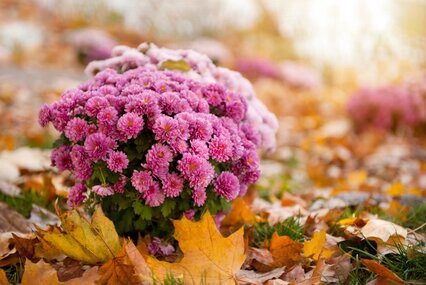Chrysanthemums are fall's signature flower, so it's no wonder that you want to do all you can to enjoy them all season long. While you can bring home new mums each season, they will actually often return to your beds on an annual or biennial basis if you leave them in the ground, but proper care is essential if go this route. "Mums add gorgeous touches of color to your outdoor garden beds just as summer flowers are fading," says Bloomscape's Plant Mom, Joyce Mast. "The blazing reds, yellows, and oranges found in outdoor garden mums also look great in containers on porches and patios."
Along with bringing color to your yard, mums are also low maintenance, says Benjamin Godfrey, garden manager at Cornerstone Sonoma. "Mums are easy to grow," he explains. "They prefer full sun, but usually do fine in part shade, and once established, they are resistant to drought, disease, and infestation." However, without the proper care, these blooms can weaken and fade fairly quickly. Curious about what steps you can take to ensure your mums keep blooming throughout the season? We asked Godfrey and Mast to share their advice, and this is what they had to say.
Water—but don't overwater—your mums according to their growth cycle.
While established mums can be watered as infrequently as once per week, Godfrey says that younger plants need more frequent watering to encourage bigger and brighter blooms. "This is especially important when the plant begins flowering, because if the chrysanthemum wilts, it can lose all its blooms. However, he also says that it's equally important to avoid overwatering them. "If the soil is saturated for too long, the roots will start to drown and the plant will weaken and become susceptible to disease," he says.

Fertilize your mums in the spring and summer.
To encourage growth and root production before the cold weather season, Godfrey suggests fertilizing your mums when you plant them in the spring and early summer. "Avoid fertilizing your mums in the fall," he warns. "The plant may be tricked into returning to a growth cycle when you want it to put its energy into flowering."
Mulch matters.
Once autumn temperatures begin to fall, Mast says it's a good idea to blanket or mulch your garden beds with old leaves or wood chips, applying four to five inches around the base of each plant. "Once the ground freezes, the protective mulch remains around the base," she says.
Pinch your mums, please.
Godfrey says the secret to maximizing flower production is to begin pinching the stems of your mums in the springtime. "Every time they grow five to six inches, pinch the tip of each shoot about two to three inches down the stem, just above the leaves," he advises. "Each pinched stem will produce more stems, which can be pinched again when they're another five to six inches tall." Godfrey says to continue this process into July, when the growth cycle naturally slows down. "This will create a fuller plant with more branches that will produce much more flowers."
Cut back old stems.
When winter approaches, our experts say you can preserve your mums for the next year by cutting back the old stems. "Cut the stems down about an inch or two above the soil and you may just see them reappear in the spring," Mast says. Additionally, Godfrey recommends "tucking in" the dormant plant by putting a layer of mulch on top of it, to protect it from future cold weather extremes.
Don't forget to deadhead.
If you aren't removing the old foliage and spent blooms from your mums, Godfrey says you're doing it wrong. "Another important way to keep your mums looking good all fall is to deadhead the spent flowers before they're completely dead," he explains. "Not only will this eliminate the brown spots, it will encourage the plant to put its energy into flower production."